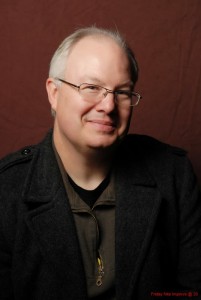Capes & Clockwork 2 Author Interview: David J. Fielding
As a way of celebrating the release of Capes & Clockwork: Superheroes in the Age of Steam, Volume 2, I’m interviewing some of the contributing authors.
Today, we talk with David J. Fielding.
- Tell us about yourself and how you got started writing.
My name is David J. Fielding, and I’m an actor and writer, most well known for playing the original Zordon on the Mighty Morphin’ Power Rangers TV show. I got my start writing in High School. And when I say my start, I mean I started copying the style and genres of the types of books I was reading at the time – pulps and Stephen King mostly. Action oriented and adventure stories. I was fascinated with heroes and fantasy and anything that had the smack of ‘magic’ about it – meaning anything that made the real world seem more tolerable.
- What genres do you prefer writing and why?
I prefer to write in those genres that fall under the speculative fiction banner – so pulp-themed stories, paranormal, superhero fiction, all the things I enjoy reading myself – anything that isn’t considered straight fiction really. Why do I like to write stories of that type? Because I find them exciting and enjoyable – it’s great fun exploring other realms and distant worlds or times, letting my imagination roam free and seeing what I find out there in the ether. And it’s a challenge to make it relevant to our real world experiences, and when the two meet up, it’s really a magical moment.
- What drew you to Capes & Clockwork?
The idea of a steampunk setting is exciting to me, it conjures up images of gaslight and fog, a Victorian age filled with airships and robots and contraptions fueled by steam and aether – rich with storytelling potential. Mix that with superheroes and it opens up even more. A Superman-type battling giant Steam-Mechs? Who wouldn’t want to read about that!?.
- Give us a quick blurb about your story?
My story, “Ten Thousand Several Doors” picks up some time after my story that was in C&C 1, and has the same main characters. The plot involves time travel, the question of whether a good deed is good if the consequences are evil and heroic sacrifice.
- Tell us about your hero and what drives them to be a good guy or gal?
My hero, Nate Vance – also known as the Harrier – is a man cut from the same cloth as John Wayne and Doc Savage. He is a man who was born to be a hero and fighter, someone who fights injustice and evil because it’s the right thing to do. He has no other drive or purpose, he’s just a four-color pulp hero. A square-jawed, two-fisted champion.
- Were there challenges for you in writing a cross-over genre (steampunk and superhero)?
I guess the only real challenge was keeping the setting consistent. As this story jumps back and forth through time – I had to make sure steampunk elements were represented in each sliver of the time periods we visit in the story.
- Who do you prefer writing? The heroes or the villains.
I like writing the villains, honestly. The heroes (especially in this type genre) are easy for me – they are black and white, their motivations pretty pure and straight forward. Well, at least mine are. Villains are more of a challenge – they need to be shaded, their motivations and methods need to be dark and twisted, yet also they have to make sense – or at least they need to seem plausible. It would be too easy to write a Max Fleischer type madman… what I wanted was someone whose objectives were for the most part good, but in the end cause more danger and mayhem than was intended.
Check out David’s story, Ten Thousand Several Doors in Capes & Clockwork, Vol. 2
And his story, AT the Quiet Limit of the World in the original Capes & Clockwork.

